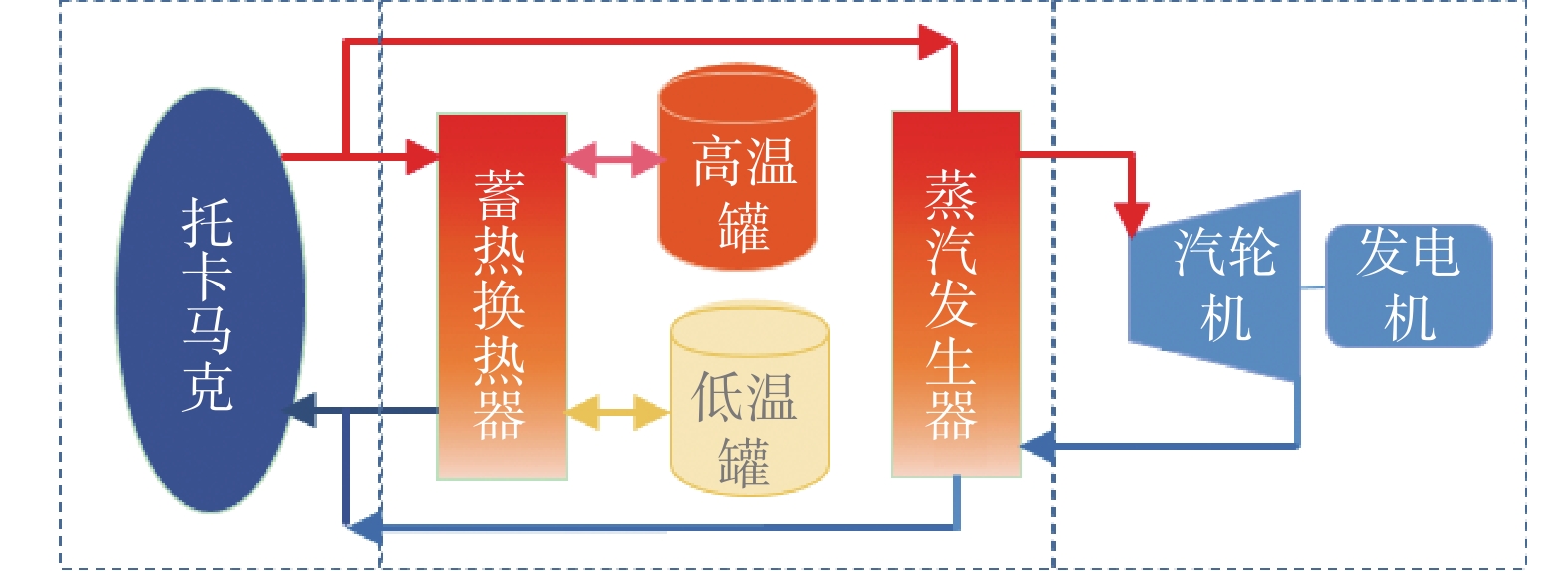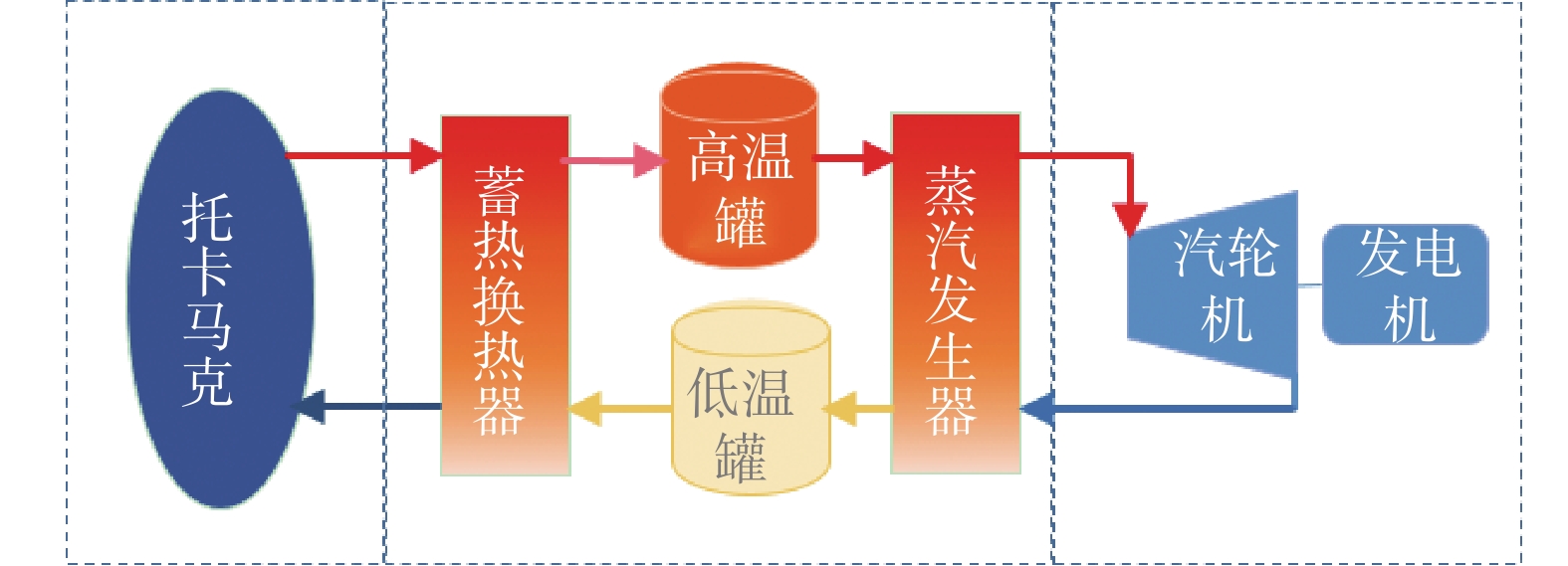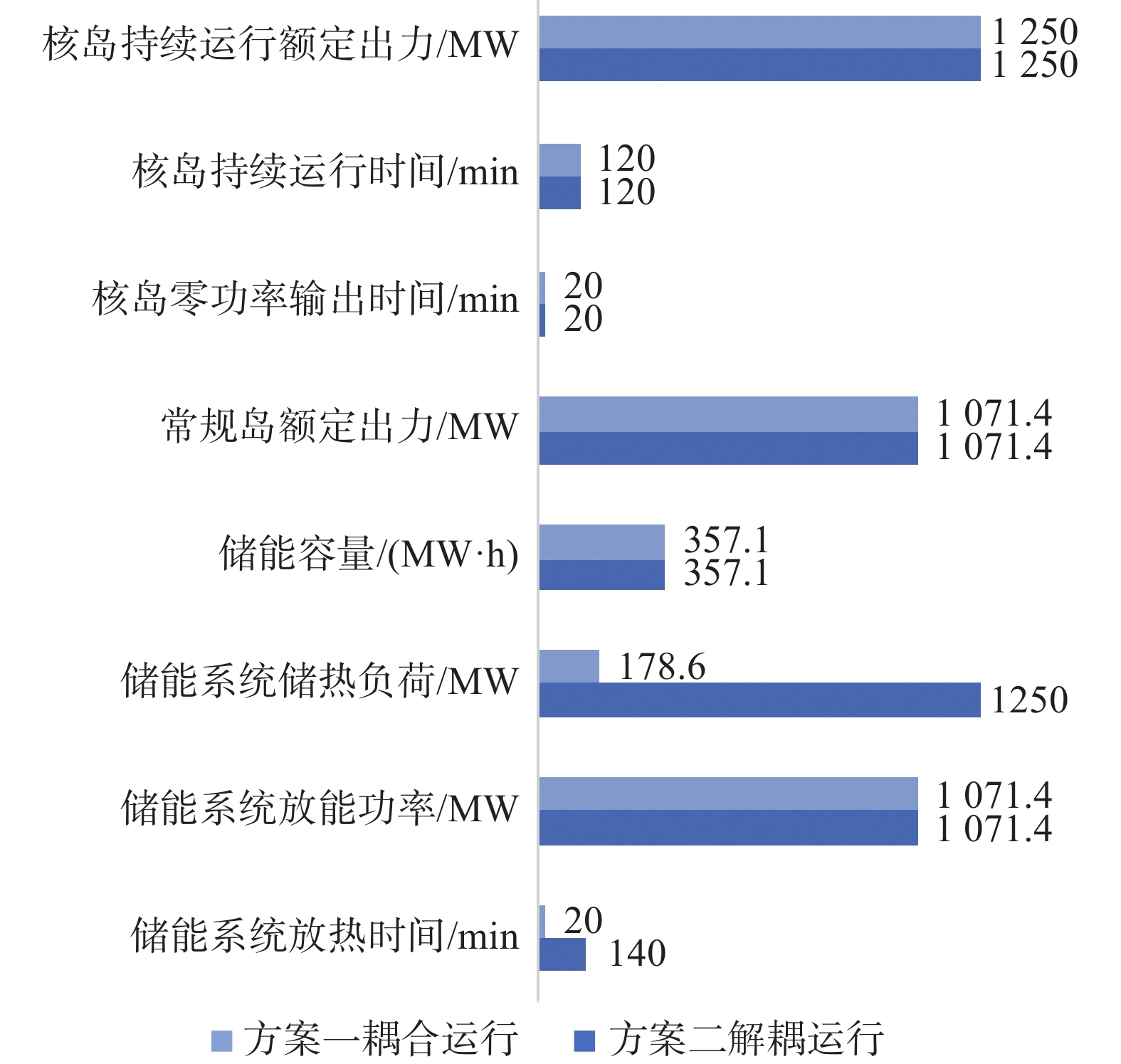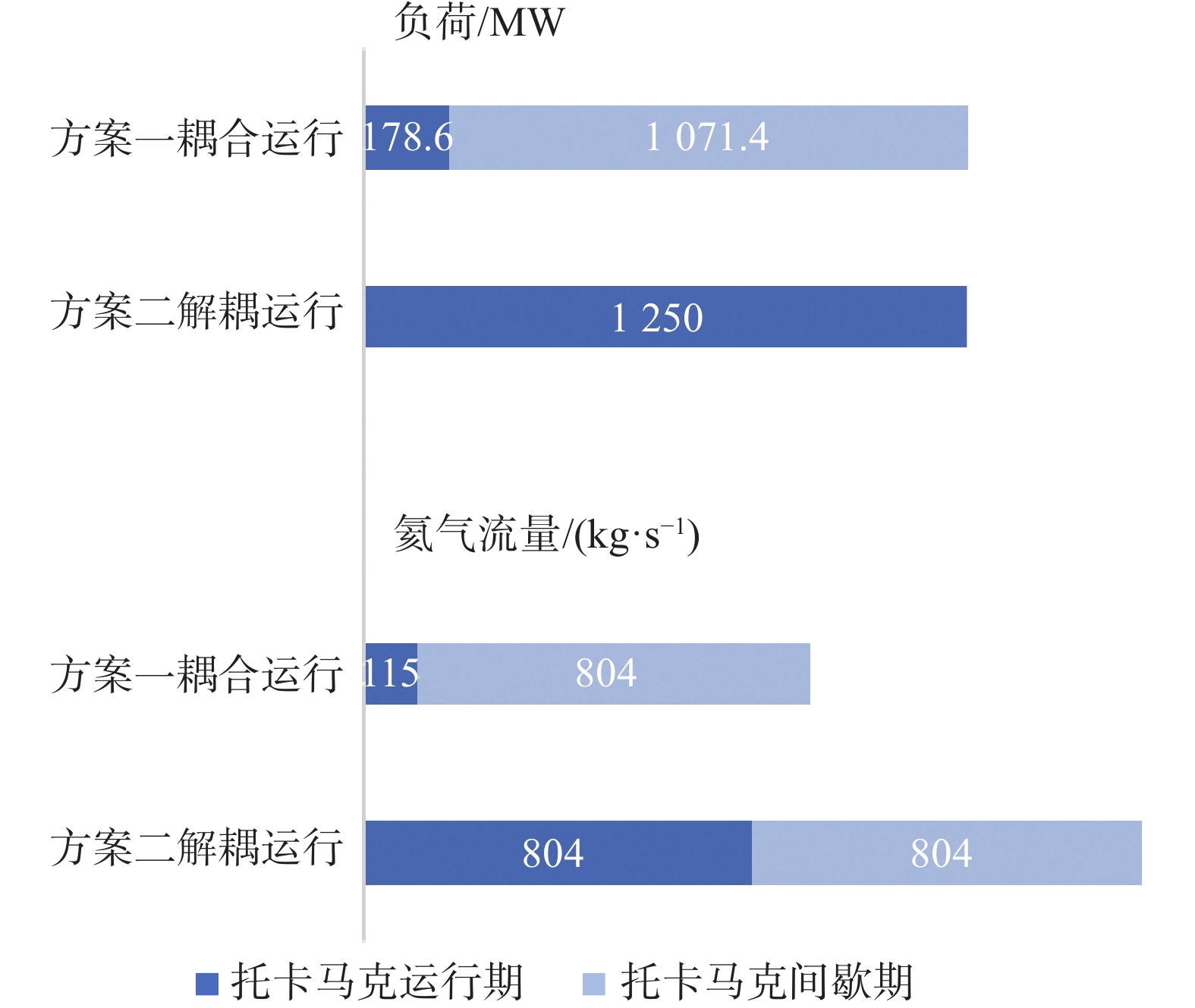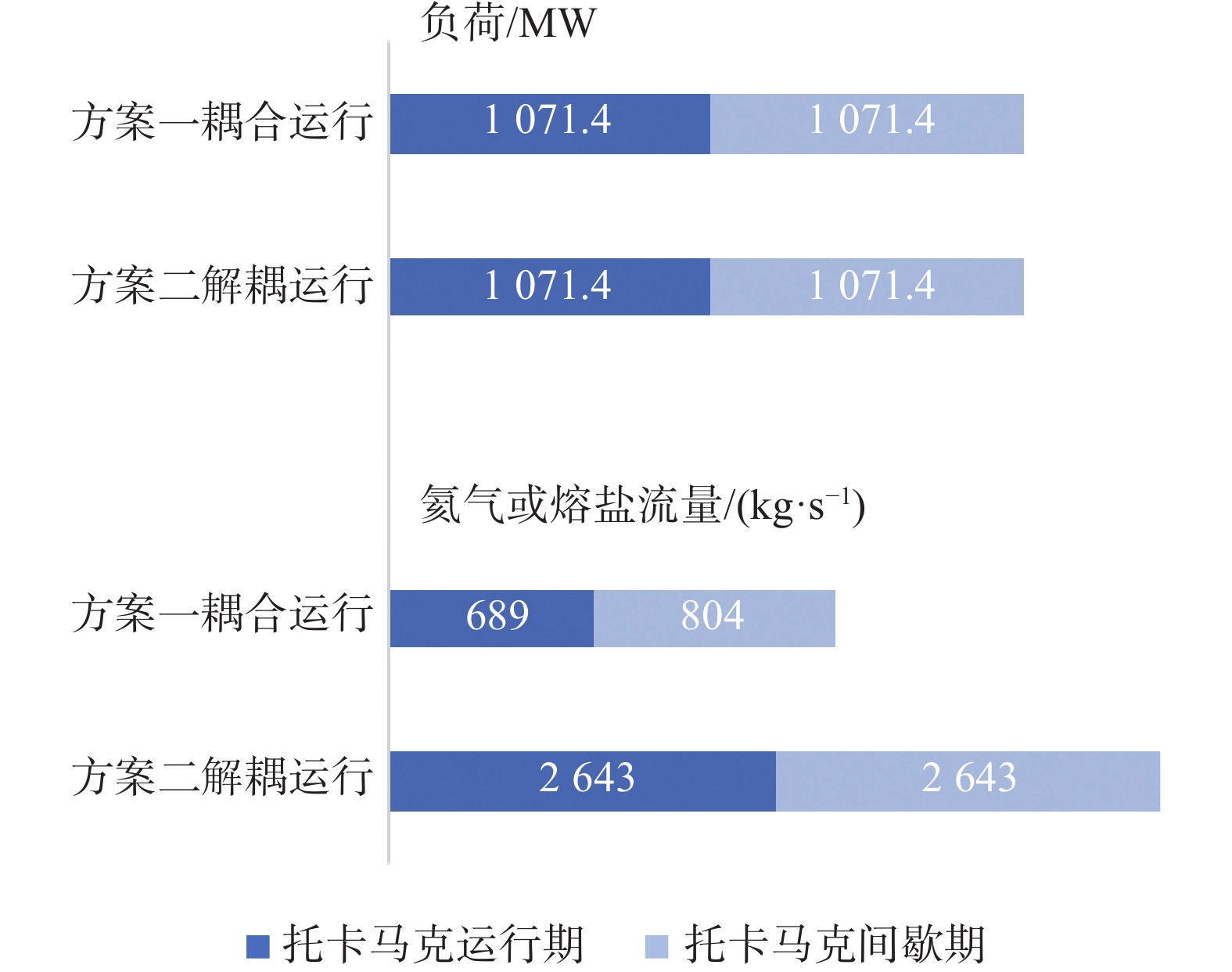-
在全球应对气候变化行动中,能源结构绿色低碳转型是最重要的措施,具有清洁低碳、稳定高效优势的核能在推动能源转型中的作用愈加受到重视[1]。原子核反应中释放的能量为核能,包括裂变能、聚变能和衰变能,可大规模应用的为裂变能和聚变能,目前用于发电的核能是核裂变能[2]。不同于核裂变产生的高放射性核废料存在安全隐患的问题,核聚变产生的唯一废料氦气不具有放射性,是一种清洁绿色能源,被视为人类未来的“终极能源”[3-5]。
聚变堆是能受控制释放聚变能量的装置。1983年我国就提出了“热堆-快堆-聚变堆”的核能发展“三步走”路径[6-7]。核聚变作为一种新型核能利用形式,是我国在能源发展道路上的必经之路。由于具有优良的等离子体约束性能,目前托卡马克装置被认为是最有可能率先成功的受控热核聚变装置[8-10]。中国聚变工程实验堆(China Fusion Engineering Test Reactor,CFETR)是我国在国际热核聚变实验反应堆(International Thermonuclear Experiment Reactor,ITER)技术的基础上,开展的下一代超导聚变堆研究的重大项目;计划到2035年建成试验堆,2050年开始建设商业聚变示范电站[11-12]。
热核聚变发电厂工程的目的是实现托卡马克聚变堆输出热能、热能转换成电能、并把电能输送到电网。托卡马克装置由于线圈磁体伏秒数的限制,现阶段只能以脉冲模式运行,随着加热能力及物理模式的发展,等离子体脉冲时长已延长到分钟量级,稳态高约束模式放电时间可达400 s以上[13-16]。CFETR聚变反应堆具有周期性、脉冲式的输出特性。而常规岛内汽轮发电机组的典型运行模式是稳定、连续的。因此需要在聚变反应堆核岛与常规岛间设置储能缓冲系统(中间回路),将核岛间断的能量输出调整为连续的能量输出,再传递给汽轮机组发电。为实现其储能缓冲的功能,储能系统需选择合适的运行模式;文章对储能系统不同的运行模式进行深入分析研究,从而得到最优的运行模式。
-
根据我国热核聚变堆的预期及当前规划,现阶段热核聚变发电厂的运行特性假定如下。核岛侧能量输出为:
1)核岛的额定输出热功率为1.25 GW。
2)核岛的典型运行模式为:以额定热功率运行2 h,而后零功率输出20 min,以此反复运行;功率运行时有小幅波动,此阶段暂不考虑。
3)采用氦气作为包层冷却介质,即核岛一回路工质为氦气;蓄热换热中氦气侧的参数为300 ℃(入口)/600 ℃(出口)/12 MPa。
针对每个托卡马克装置配置一套储能装置、一套汽轮发电机组,即一堆一储一机配置方案。中间回路相关的系统、设备及附属设施统称为储能岛。常规岛和储能岛尽量采用当前成熟技术,以实现规模化商业应用。
-
热核聚变发电厂发电过程中的能量转换基本环节如图1所示。
托卡马克装置聚变反应产生的核能在加热核岛回路冷却剂氦气的过程中转换为氦气的热能(内能),实现核能到热能的转变。
核岛回路中的高温氦气经托卡马克加热后出核岛进入储能岛蓄热交换器,将储能回路中的储热介质加热为高温。核岛回路氦气的热能转换为储能回路储热介质的热能。被冷却后的氦气回到核岛。
储能回路的高温储热介质通过蒸汽发生器释放热量,加热常规岛回路的水产生高温蒸汽,即储能回路的热能转换为常规岛回路水蒸汽的热能。放热后的低温储热介质由储能泵送回到蓄热交热器中再次储热,以此循环。
常规岛回路高温高压水蒸汽,进入汽轮机做功,即热能转换为机械能。做功后的乏汽在凝汽器中凝结成水,经给水泵送回到蒸汽发生器中,被高温储热介质加热再次产生高温水蒸汽。
汽轮机带动发电机转动产生电量,对外输送,即机械能转换为电能。
-
根据核聚变堆的典型运行模式,定义T为一个运行周期的时长,其中0~$ {{T}}_{\mathrm{o}\mathrm{p}} $时段内托卡马克输出100%功率$ {{P}}_{\mathrm{n}\mathrm{i}} $,$ T_{\mathrm{o}\mathrm{p}} $~T时段内托卡马克输出功率为0。经过储能系统调节后进入常规岛的能量功率应该是连续、稳定的,即在T周期内均为$ {{P}}_{\mathrm{c}\mathrm{i}} $,由能量平衡可得以下关系:
$$ {{P}}_{\mathrm{n}\mathrm{i}}{{T}}_{\mathrm{o}\mathrm{p}}={{P}}_{\mathrm{c}\mathrm{i}}{T} $$ (1) 在托卡马克运行期,即0~$ {{T}}_{\mathrm{o}\mathrm{p}} $时段内储能系统处于储能模式,如果核岛直接给常规岛传递热量,同时将多余热量传递给储能系统,此时储能系统充能功率最小:
$$ {{{P}}_{{\mathrm{si}},{\mathrm{in}}}={P}}_{\mathrm{n}\mathrm{i}}-{{P}}_{\mathrm{c}\mathrm{i}}=\left(1-\frac{{{T}}_{\mathrm{o}\mathrm{p}}}{{T}}\right){{P}}_{\mathrm{n}\mathrm{i}} $$ (2) 在托卡马克运行期,若核岛能量都由储能系统吸收,则此时储能系统充能功率最大:
$$ {{{P}}_{{\mathrm{si}},{\mathrm{in}}}={P}}_{\mathrm{n}\mathrm{i}} $$ (3) 在托卡马克间歇期,即$ \mathrm{\mathit{T}}_{\mathrm{o}\mathrm{p}} $~T时段内储能系统处于释放模式,其放能功率为:
$$ {{{P}}_{{\mathrm{si}},{\mathrm{out}}}={P}}_{\mathrm{c}\mathrm{i}}={\frac{{{T}}_{\mathrm{o}\mathrm{p}}}{{T}}{P}}_{\mathrm{n}\mathrm{i}} $$ (4) 储能系统理论所需储能容量为:
$$ {{{Q}}_{{\mathrm{si}}}={P}}_{\mathrm{s}\mathrm{i},\mathrm{i}\mathrm{n}}{{T}}_{\mathrm{o}\mathrm{p}}=\left(1-\frac{{{T}}_{\mathrm{o}\mathrm{p}}}{{T}}\right){{{T}}_{\mathrm{o}\mathrm{p}}{P}}_{\mathrm{n}\mathrm{i}} $$ (5) 根据核岛的边界条件,各参数计算汇总如表1所示。
参数 数值 核岛运行时额定输出功率/MW 1 250 一个运行周期内核岛输出额定功率时间/min 120 一个运行周期/min 140 常规岛额定输入功率/MW 1 071.4 储能系统充能功率/MW 178.6~1 250 储能系统容量/MWh 357.1 储能系统放能功率/MW 1 071.4 发电机额定功率/MW 428 Table 1. Capacity of energy storage island and conventional island
由表1可知,未考虑损耗的理论计算下,核岛通过储能系统释放的平均能量为1 071.4 MW,按发电效率为40%进行估算,常规岛汽轮发电机组为400 MW等级;储能系统的储能容量为357.1 MWh,充能功率为178.6~1 250 MW,放能功率为1 071.4 MW。
-
依据核岛回路中的氦气参数,储能岛推荐采用显热储热形式、储热介质采用熔融盐。熔融盐是目前在光热电站中普遍应用、较为成熟的中高温储热介质。本项目储能岛采用间接式双罐储热系统[17-19],间接式双罐储热系统运行控制简单明确,是当前聚变发电研究中的主流储热方案[20-22]。
间接式双罐储热系统可分为两种形式,如图2和图3所示。二者运行模式的主要区别在于核岛与常规岛是否可以解耦运行。方案一如图2所示,核岛与常规岛是耦合运行的;方案二如图3所示,核岛与常规岛是解耦运行的。
储能岛由蓄放热系统、蒸汽发生系统和防凝、排盐等附属系统组成,主要设备包括蓄热交热器、蒸汽发生器、高温罐、低温罐和冷、热盐泵等。
-
图2所示方案一的主要特点是核岛回路与常规岛朗肯循环有直接的换热。方案一与现有槽式光热电站的主流储热方案类似,只是槽式光热电站中储热介质采用导热油。方案一的运行方式如下:
1)$ 0\sim{{T}}_{\mathrm{o}\mathrm{p}} $期
被托卡马克加热后的高温氦气一分为二,从核岛出来后一路进入蒸汽发生器与水非接触性换热产生高温蒸汽,蒸汽去往常规岛发电;另一路进入蓄热交热器与从低温储罐经冷盐泵送入的液态熔盐非接触性换热、加热熔盐,高温熔盐进入高温储罐储存;两路氦气分别被冷却后,汇合重新回到核岛进入托卡马克。
2)$ {{T}}_{\mathrm{o}\mathrm{p}}\sim{T} $期
氦气从核岛出来后进入蓄热交热器与从高温储罐经热盐泵送入的液态熔盐非接触性换热;放热后的熔盐回到冷盐罐储存;被加热后的高温氦气进入蒸汽发生器与水非接触性换热产生高温蒸汽、蒸汽去往常规岛发电;被冷却后的氦气回到核岛进入托卡马克。
图3所示方案二的主要特点是核岛回路与常规岛朗肯循环没有直接的换热,两者之间的所有热量传递都经过储热系统。方案二与现有塔式光热电站的主流储热方案类似。方案二的运行方式如下:
1)$ 0\sim{{T}}_{\mathrm{o}\mathrm{p}} $期
被托卡马克加热后的高温氦气从核岛出来后进入蓄热交热器与经冷盐泵送入的液态熔盐非接触性换热、加热熔盐;氦气被冷却后回到核岛进入托卡马克;高温熔盐进入高温储罐储存;同时部分高温熔盐经热盐泵送往蒸汽发生器与水非接触性换热、产生高温蒸汽,蒸汽去往常规岛发电;熔盐放热后回到低温储罐。
2)$ {{T}}_{\mathrm{o}\mathrm{p}}\sim{T} $期
氦气从核岛出来后进入蓄热交热器,此时由于蓄热交热器熔盐侧管道被隔离,氦气未经换热又重新回到核岛进入托卡马克;高温储罐中储存的剩余高温熔盐经热盐泵送往蒸汽发生器与水非接触性换热、产生高温蒸汽,蒸汽去往常规岛发电;熔盐放热后回到低温储罐。
-
方案一在$ {{T}}_{\mathrm{o}\mathrm{p}}\sim{T} $核岛零功率输出期间,蓄热后的熔盐需再换热给氦气,通过氦气在蒸汽发生器中传热产生高温水蒸汽。即热量传递过程经过氦气、熔盐、氦气、水蒸气,经过了3次换热;而方案二中,热量传递过程经过氦气、熔盐、水蒸气,只经过两次换热。因此,相比方案一,方案二中常规岛的主蒸汽可实现更高的温度。考虑换热器最小10 ℃的端差,即方案一的主蒸汽温度将比方案二低10 ℃以上,这将降低常规岛回路的热效率。方案一若要实现同方案二的主蒸汽参数,则对蒸汽发生器在端差等控制设计上提出更高的要求。
总体而言,方案二更有利于常规岛回路实现较高的热效率。
-
根据核岛的功率输出特性,图4列出了不同方案下机组的储能出力需求。
两个方案的换热介质均为氦气和熔盐。基于图4的功能要求,蓄热交热器的初步参数计算结果如图5所示。
从图5可以看出,在储热侧,方案一在0~$ {{T}}_{\mathrm{o}\mathrm{p}} $托卡马克运行期储热负荷为178.6 MW,在$ {{T}}_{\mathrm{o}\mathrm{p}}\sim{T} $托卡马克间歇期储热负荷为1 071.4 MW,方案二整个运行期间的储热负荷为1 250 MW。两个方案的蓄热交热器换热介质均为氦气-熔盐。因此对蓄热交热器而言,方案一比方案二的换热面积可略少。
为满足常规岛回路侧的负荷稳定,在储热和放热阶段,需保证蒸汽发生器的输入热负荷相同。为实现该功能,方案二中蓄热交热器在周期运行期内的负荷及参数变化较大。在储热阶段,蓄热交热器的负荷为178.6 MW,氦气流量为114.8 kg/s、进出口温度为600/300 ℃;在放热阶段,蓄热交热器的负荷为1 071.4 MW,氦气流量为803.5 kg/s、进出口温度为300/600 ℃。在周期运行期内的不同阶段,设备内的介质流量变化大,而且进、出口温度是相反的。因此,对蓄热交热器的设计制造也提出很高得的要求,需进行深入的专项研究。方案一中蓄热交热器在整个周期运行期负荷虽有变化,但介质流量及温度保持稳定,相对可用常规的成熟设计即可。
基于图4的功能要求,蒸汽发生器的初步参数如图6所示。在耦合运行的方案一中,蒸汽发生器内发生氦气与水的热交换;在解耦运行的方案二中,蒸汽发生器换热的两个介质为熔盐与水。
在放热侧,两个方案的负荷是相同的,均为1 071.4 MWh,区别是方案一为氦气蒸汽发生系统,方案二为熔盐蒸汽发生系统。氦气工作压力为12 MPa,高压水或水蒸汽的压力也大于10 MPa,熔盐工作压力则较低,一般为2 MPa。熔盐蒸汽发生系统可按常规设计,高压水或蒸汽一般走管程,低压的熔盐走壳程,由于壳程压力较低,换热器壳侧壁厚较小。而对于氦气蒸汽发生系统,由于氦气蒸汽发生器中氦气和水侧的工作压力都很高,无论哪种介质走壳程都会使壳程压力高,而且壳程直径通常较大,壳程壁厚通常较大。因此方案一氦气蒸汽发生器的材料成本要比方案二熔盐蒸汽发生器大,设备造价高。
为满足常规岛回路的负荷稳定,在储热和放热阶段,需保证蒸汽发生器的输入热负荷相同。为实现该功能,方案一中蒸汽发生器在不同运行期内的介质流量不同;蒸汽发生器在储热阶段的氦气流量为688.8 kg/s,放热阶段的氦气流量为803.5 kg/s,流量的变化约为总流量的14.3%;蒸汽发生器如何能够提供二回路稳定参数,需进行深入的专项研究。因此,方案一对设备制造、控制切换的时点都提出比较高的要求。而方案二在整个周期运行期,蒸汽发生器内介质参数稳定,可采用常规成熟的设计方案。
-
两个方案下,各回路泵的运行情况比较如表2所示。
项目 耦合运行 解耦运行 核岛氦气侧 运行2 h停20 min 运行2 h停20 min 储能岛熔盐侧储热 冷盐泵以1/6负荷运
行2 h后停泵20 min冷盐泵以7/6负荷运行
2 h后停泵20 min储能岛熔盐侧放热 热盐泵满负荷运行
20 min后停泵2 h热盐泵满负荷持续运行 常规岛汽水侧 持续运行 持续运行 Table 2. Pump operation of each loop
方案一储热和放热需要周期性切换;0~$ {{T}}_{\mathrm{o}\mathrm{p}} $储热期关闭热盐泵,启动冷盐泵将熔盐打入蓄热交热器蓄热后回到高温罐;$ {{T}}_{\mathrm{o}\mathrm{p}}\sim{T} $放热期关闭冷盐泵,启动热盐泵将熔盐打入蓄热交热器放热后进入低温罐;对于蓄热交热器需要周期性切换熔盐流动方向。
方案二在0~$ {{T}}_{\mathrm{o}\mathrm{p}} $储热期启动冷盐泵将熔盐打入蓄热交热器蓄热后回到高温罐,$ {{T}}_{\mathrm{o}\mathrm{p}}\sim{T} $放热期关闭冷盐泵;$ 0\sim{T} $整个运行期,热盐泵持续运行;蓄热交热器运行模式相对简单。
需要周期性切换的设备中,方案一包括冷盐泵及出口隔离阀、热盐泵及出口隔离阀、低温罐入口隔离阀、高温罐入口隔离阀、氦气去蒸汽发生器隔离阀、蓄热交热器后氦气去蒸汽发生器隔离阀等;方案二仅包括冷盐泵及出口隔离阀、蓄热交热器熔盐侧进出口隔离阀。由于核岛周期性运行的特性,储能岛中设备周期性运行无法完全避免;方案二相对而言周期性运行设备已减到最少。
-
由上述分析比较可知,方案二相较方案一,常规岛回路可产生更高的蒸汽参数,进而汽轮发电机组得到更高的热效率;在蓄热交热器和蒸汽发生器的设计、制造上,可采用相对成熟的技术,技术风险低、方案的可行性更高;在周期性运行切换上,对设备和阀门的制造和控制要求相对更低。因此,推荐采用方案二。
-
储能系统合理的运行模式关系着热核聚变发电厂电能稳定输出的顺利实现;核岛与常规岛耦合运行还是解耦运行,对应着储能系统不同的运行模式。文章基于CFETR功率输出的特性,对储能系统从系统配置、技术成熟性、运行方便性等方面进行全面地分析研究。经对比分析可知,核岛与常规岛解耦的运行模式在常规岛发电效率、蓄热交热器等关键设备选型设计和机组运行控制上都更具优势,因此热核聚变发电厂的储能系统推荐采用该运行模式。储能系统解耦的运行模式大都采用目前成熟的技术方案,因此可实现规模化的商业应用。
此外,由于托卡马克的脉冲式运行特性,热核聚变发电厂不可避免存在周期性运行的设备和阀门,建议下一阶段对其进行深入的评估分析。
Research on Operation Mode of Energy Storage System for Thermonuclear Fusion Power Plant
doi: 10.16516/j.ceec.2023-327
- Received Date: 2023-11-13
- Accepted Date: 2024-03-13
- Rev Recd Date: 2023-12-15
-
Key words:
- nuclear fusion /
- nuclear power plant /
- energy storage /
- operation mode
Abstract:
| Citation: | LIN Yan, LI Bin, LUO Haodong, et al. Research on operation mode of energy storage system for thermonuclear fusion power plant [J]. Southern energy construction, 2024, 11(3): 1-7. DOI: 10.16516/j.ceec.2023-327 doi: 10.16516/j.ceec.2023-327 |


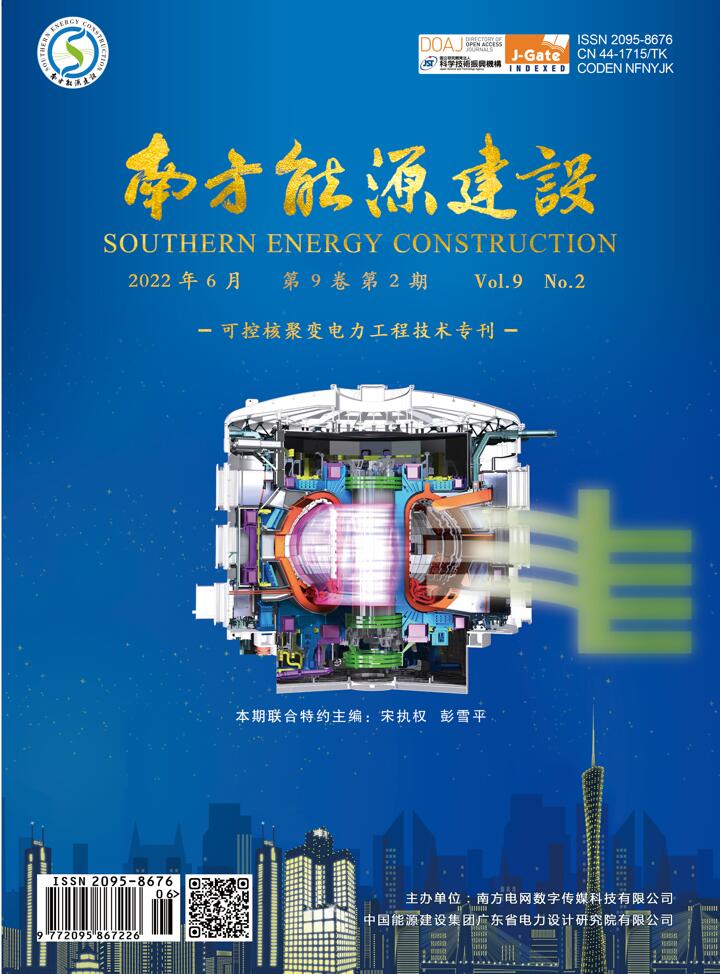










 DownLoad:
DownLoad:
